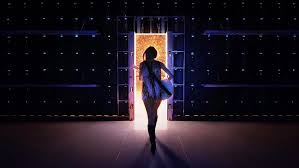Good Times Review 2024 Tv Show Series Cast Crew Online
Fifty years ago, “Good Times” became the first sitcom to depict a two-parent Black American family. Now, Netflix is debuting a present-day animated reboot chronicling the Evanses two generations after the original. Set in Chicago’s Cabrini Green projects in the same apartment from the 1970s dramedy, the series follows Reggie (J.B. Smoove), his wife Beverly (Yvette Nicole Brown) and their children, Junior (Jay Pharoah), Grey (Marsai Martin) and Dalvin (Slink Johnson). Black people aren’t a monolith, and respectability politics certainly aren’t the answer to racism, sexism, bigotry and homophobia. Yet it’s puzzling that this mind-numbing series is how creator Ranada Shepard is paying homage to such a classic show while trying to speak to 21st-century Black people. It’s also very clear why Netflix decided against sending out screeners for review.
In the season opener, “Meet the Evans of New,” we learn about the new occupants of apartment 17C. Reggie, the grandson of Florida (Esther Rolle) and James (John Amos), is a struggling cab driver with hypertension and a penchant for long, drawn-out rants. Beverly is appearance-obsessed despite her family’s financial struggles. Junior, the eldest, is an artist repeating 10th grade for the third time. Grey is whip-smart and activist-minded even to her detriment. Finally, Dalvin is a drug-dealing infant whom Reggie has thrown out of the house. The character was likely created to mirror Stewie from “Family Guy” (Seth MacFarlane is an executive producer on “Good Times”). Yet, casting him as an infant drug dealer who sells crack on the street corners is neither amusing nor edgy.
The first three episodes of “Good Times,” which is when I stopped watching, are stuffed full of repetitive stereotypes, stale jokes and bizarre choices. The Evans’ apartment is roach-infested and dilapidated. Meanwhile, most characters — including Bev’s best friend Lisa (Rashida “Sheedz” Olayiwola), who owns a beauty shop/funeral parlor combo — appear to be caricatures of Black people found in memes. Cabrini-Green, the infamous high-rise project where this story is set, is also a wild choice — since it was demolished in 2011. If you’re going to spotlight Chicago, it should be done with honesty and reverence to those who call it home. “Good Times’” perspective on the Windy City is not only narrowed and bullet-riddled, but it’s seemingly born out of a skewed gangsta rap version of the city.
Still, there are a handful of interesting components here. When Bev prays, a video game-playing Black Jesus appears, responding to or ignoring her pleas. This visualization is a direct callback to Florida from the original series calling out to God. In Episode 2, “Black of Focus,” viewers are offered an “Inside Out” visual into Junior’s mind, which directly unpacks his academic failures and artistic talent. However, Episode 3, “Grey’s Anatomy,” offers the most compelling storyline. It chronicles Grey navigating her first period as everyone, including the school nurse and Bev, tries to shame her about menstruation. In a “The Wiz”-like sequence, this chapter addresses the hypersexualization of Black girls as fast and womanly while taking direct shots at the end of Roe v. Wade through a Trump-type character, Grady Oscar Piles, aka “G.O.P.”
Despite these few highlights, “Good Times” is overrun with issues. Some of these have already spilled into the public. The original creator, Carl Jones, wrote on Twitter/X that he left the project during development due to creative differences. Moreover, Yvette Nicole Brown, who voices Beverly in the series, is being attacked on the social media platform for just being a part of the show. The late Norman Lear, BernNadette Stanis and Jimmie Walker, who played Thelma and J.J., respectively, in the original series, have minor roles. Stanis has spoken publicly about watching the new show’s trailer. “I did a little voice for them, but I did not know it was going to be the way it is. I thought it was going to be different,” she told The Hollywood Reporter. She continued, “It’s just a little here and there. But I think that they did that because they knew what their show was going to be like. So I guess they figured, if you put us in there, it wouldn’t look so bad or whatever.”
Black creators and talent have vast experiences across political, social and economic backgrounds. Like our white counterparts, we can express our experiences as we see fit. Yet, amid the recent shuttering of numerous Black-led shows, including “Rap Sh!t,” “South Side,” and “The Wonder Years,” just to name a few, it’s pathetic Hollywood is championing depictions that reduce Black people, racism and systemic issues into one-dimensional minstrels lacking present-day relevance. What’s worse is that the writing in “Good Times” just isn’t funny.
The remaining seven of the 10-episode season likely won’t be transformative or strike a different tone than the first three. For one, the series fails to infuse humor and wit into everyday hardships– which has been done masterfully in shows including “The Boondocks,” “The PJs,” or even the 1970s “Good Times.” Moreover, the reboot has an antiquated feel, as if someone wrote the scripts decades ago and unearthed them in the present, barely adding tweaks or updates. The themes addressed, including money woes and Junior’s undiagnosed ADHD, have been highlighted in copious Black-led shows throughout time. Sitcoms like “Everybody Hates Chris,” “Black-ish” and “The Cosby Show” discussed these subjects with a brilliance that fails to materialize here.
Reimagining “Good Times” for a 21st-century audience could have been done brilliantly. Animation allows for a wealth of creative freedom, enabling viewers to see characters and their experiences in ways that live-action doesn’t. While the series’ predecessor captivated viewers some five decades ago, these modern-day Evans are stuck in the past, unable or unwilling to connect with new generations who are still navigating so much and have so much to say.




